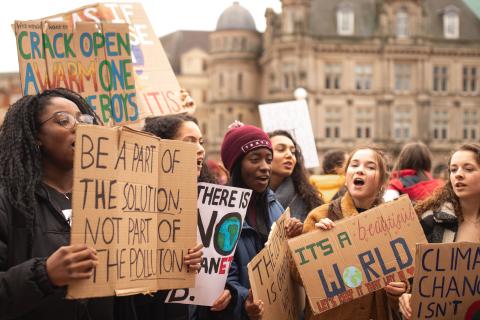The promise of Bill S-5: Vulnerable Communities, Climate Litigation and the Right to a Healthy Environment in Canada

Wynona Klemt
Allard JD Candidate 2024
Jan 19, 2023
The fossil fuel industry has always loomed large for Beze Grey, an Anishinaabe land and water defender from Aamjiwnaang First Nation in Sarnia, Ontario. The area where Gray lives is known as “Chemical Valley” due to its concentration of petrochemical refineries and industrial facilities. Gray is intimately familiar with the connections between the extractive industry, climate change, and the health of people and the environment.
That is why Gray is taking the government to court for weakening provincial climate laws. Gray and six other Ontario youth in Mathur v. Ontario are using existing constitutional rights to life, security of the person and equality to argue that the government is violating their right to a healthy environment.
A current bill to amend the Canadian Environmental Protection Act (CEPA) could soon introduce this right into federal legislation for the first time. This “modernization of CEPA” will require the government to defend everyone’s right to a healthy environment, while also considering the unique burdens faced by vulnerable communities. Thus, this proposed amendment could change the landscape for environmental justice in Canada and bolster rights-based arguments for future climate litigation.

While the laws of over 150 countries recognize the right to a healthy environment, this right has not yet been acknowledged substantively in Canadian federal law. Bill S-5 (Strengthening Environmental Protection for a Healthier Canada), could soon change this. The Bill is currently in committee in the House of Commons, after being passed by the Senate. It is the first amendment to CEPA in over two decades. This bill recognizes the right to a healthy environment. The preamble declares that every individual in Canada has a right to a healthy environment, and Section 2 obliges the Government to protect this right.
A promising aspect of this amendment is its recognition of the inequitable effects of environmental harm on vulnerable populations in Canada. The bill requires the government to exercise its powers in a manner that protects the health of vulnerable populations, which it defines as groups “within the Canadian population who, due to greater susceptibility or greater exposure, may be at an increased risk of experiencing adverse health effects from exposure to substances.” It requires the government to develop an implementation framework for the right to a healthy environment that elaborates on the principle of environmental justice, “including the avoidance of adverse effects that disproportionately affect vulnerable populations.” It also requires the government to consider the effects on vulnerable populations when conducting toxic substance risk assessments.
Additionally, Bill S-5 declares the government’s commitment to implement United Nations Declaration on the Rights of Indigenous Peoples (UNDRIP), which Canada embraced in 2016.
This acknowledgement of the importance of the right to a healthy environment for vulnerable communities holds promise for championing environmental justice and climate rights. Racialized and poor communities have historically faced a higher burden in dealing with environmental harms, and are likely to experience adverse impacts of climate change sooner. In an interview with CBC, Gray shared their hope that the Mathur lawsuit will draw attention to the fact that the climate crisis has a disproportionate impact on Indigenous communities. The climate crisis is a global ecological and humanitarian issue, but the effects of climate change are not felt equally by all.
By acknowledging the environmental inequalities faced by vulnerable communities, Bill S-5 represents a major advance in Canadian environmental legislation. As this bill has progressed through Parliament, environmental groups have fought to ensure that the legal right to a healthy environment will have teeth.

The bill is being considered in the shadow of the 2022 UN General Assembly Resolution (A/76/L.75), which recognized that the right to a “clean, healthy and sustainable environment for all” is a human right. Substantively, this right includes access to clean air and water, a non-toxic environment in which to work and live, and a stable climate.
International treaties such as the Paris Agreement on climate change have set the stage to encourage governments to take decisive action domestically to ensure that a safe climate is maintained globally. Increasingly, citizens around the world are taking a stand against their governments’ inadequate climate policies, invoking rights-based arguments such as the right to a healthy environment. David Boyd, UN Special Rapporteur on Human Rights and the Environment, refers to the UNGA resolution as a “catalyst for action,” that can help “empower people to hold their governments accountable.”
The right to a healthy environment has been a key instrument in advancing climate litigation around the world. In countries where this right is constitutionally protected, advocates have been able to invoke this right when addressing the shortcomings of climate policies or other environmental injustices, such as in Future Generations v. Ministry of the Environment and Others. In this case, youth plaintiffs successfully challenged the Colombian government’s inadequate protection of the Amazon rainforest. They argued that deforestation led to increased greenhouse gases, undermining the health of the environment, and resulting in poor health outcomes.
In Canada, efforts to advance rights-based arguments around climate change, as in Mathur, have relied on more general constitutional provisions such as the Section 7 right to life, liberty and security of the person, and Section 15 equality rights. Canadian courts have yet to determine whether Charter rights include environmental/climate rights.

While the bill’s characterization of the right to a healthy environment is not perfect, it can help set the stage for important future reforms. One critique is that this right will not hold much power unless it is constitutionalized. However, constitutional rights are not the only way to invoke government obligations. By placing a duty on the government to protect the right to a healthy environment and to consider disproportionate impacts on vulnerable populations, the bill will put pressure on the government to take the right seriously.
The right to a healthy environment could supplement constitutional rights and provide another line of reasoning when invoking rights-based arguments against government climate action or inaction. Reopening the Constitution is unlikely to happen anytime soon.
There are also fears that the application of the right could be limited to toxic substances law. While CEPA does focus largely on toxic substances, its scope is much broader than that. Moreover, the connection between toxic substances, environmental degradation and climate change is apparent, especially for communities located near GHG-intensive industries.
For Indigenous communities, these confounding factors can have a detrimental effect on their connection to the land. Community members become disconnected from their culturally significant food sources and ecosystems, and their health and wellbeing ultimately suffer – something Gray has observed in Aamjiwnaang.
This legislation presents a clear opportunity for the right to a healthy environment to play an important contributory role in the future of environmental rights and climate litigation in Canada, especially given its emphasis on vulnerable communities.
Beze Gray and the other youth in the Mathur case have already passed several hurdles in their journey through the courts. The case was heard on its merits on September 12-14, 2022, and judgment is pending. The decision will set an important precedent for the interpretation of Charter rights in the context of environmental rights.
Regardless of the outcome, future climate litigants will need every tool available in holding provincial and federal governments accountable. The right to a healthy environment could be one of those tools. While we should continue to fight to ensure that this right is broadly applicable, practical and enforceable, legislating it with specific acknowledgement of the government’s obligations to vulnerable populations is an important starting point for advancing environmental justice and strengthening climate rights in Canada.
- Centre for Law and the Environment

